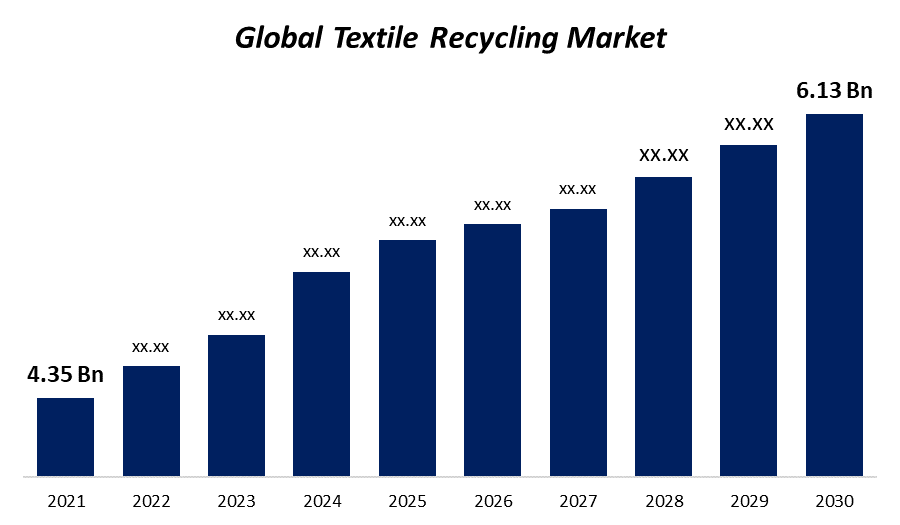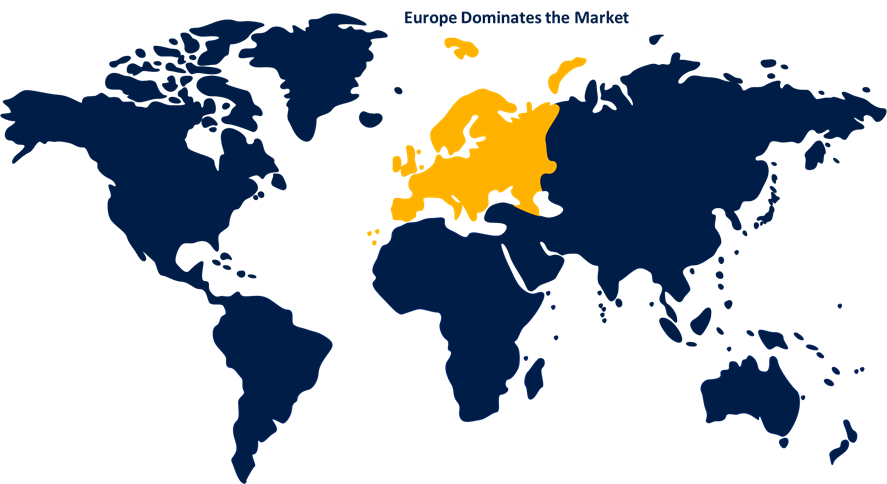Global Textile Recycling Market Size, Share, and COVID-19 Impact Analysis By Material (Cotton, Polyester, Wool, Polyamide and Others), By Source (Apparel Waste, Home Furnishing Waste, Automotive Waste and Other), By Process (Mechanical and Chemical) and By Region (North America, Europe, Asia-Pacific, Latin America, Middle East and Africa), Analysis and Forecast 2021 - 2030.
Industry: Specialty & Fine ChemicalsGlobal Textile Recycling Market Insights Forecasts to 2030
- The Global Textile Recycling market was valued at USD 4.35 billion in 2021.
- The market is growing at a CAGR of 3.9% from 2021 to 2030
- The Global Textile Recycling market is expected to reach USD 6.13 billion by 2030
- The Asia Pacific is expected to grow the fastest during the forecast period

Get more details on this report -
The Global Textile Recycling market is expected to reach USD 6.13 billion by 2030, at a CAGR of 3.9% during the forecast period 2021 to 2030. The rising environmental concern over garbage production and growing public awareness of textile recycling is expected to increase the development of the market for textile recycling.
Market Overview
Used clothing and textile waste are recycled to generate recycled textiles. The practice of recycling used clothing, fibrous materials, and even manufacturing waste involves employing textiles. The majority of textiles that are recyclable are created from municipal waste, including old or discarded carpets, clothing, furniture, tyres, shoes, and other non-durable items like towels and sheets. Recycling is the process of turning used materials and garments into new products. Reduced need for new materials like cotton and wool, pollution, and energy and water use are all indicators of the economic and environmental benefits of recycled fabrics. The demand for freshly created fibres can be reduced by using the fabrics and fibres already available. By conserving energy, water, chemicals, and colours, lowers pollution. By recycling, businesses can increase their profit margins by avoiding the expense of landfill disposal, while also improving the quality and value of the environment, hiring workers that haven't worked for charity, aiding in disaster relief, and transporting used clothing to areas in need. An increase in recycling operations and rising demand from a variety of industries, including the retail sector, the automotive industry, and the building and construction industry, are what is fueling the growth of the global recycled textile market. The price of recycled materials is predicted to be relatively low compared to the cost of new products, which will also help the recycled textile industry grow. However, rising processing costs and a lack of employment opportunities are expected to restrain the growth of the global market for recovered textiles. It is predicted that throughout this time, the advancement of recycling technology would present profitable expansion prospects for the recycled textile industry. Government and non-profit activities have raised consumer awareness of textile recycling. As a result of greater awareness, there has been a notable increase in waste textile donations and collections, which supports the expansion of the world's recycled textile industry. The company can get a number of cost advantages by using recovered textiles. Virgin fibres are significantly more expensive than recycled materials. It is preferable to transition to recycled textiles because virgin materials are not always readily available, which slows down production and increases the overall cost of manufacturing. Additionally, the processing of recycled materials like wool, cotton, and polyester is less complicated, which raises the need for recycled textiles.
Report Coverage
This research report categorizes the market for Global Textile Recycling based on various segments and regions, forecasts revenue growth, and analyses trends in each submarket. The report analyses the key growth drivers, opportunities, and challenges influencing The Global Textile Recycling market. Recent market developments and competitive strategies such as expansion, product launch and development, partnership, merger, and acquisition have been included to draw the competitive landscape in the market. The report strategically identifies and profiles the key market players and analyses their core competencies in each Global Textile Recycling market sub-segments.
Global Textile Recycling Market Report Coverage
| Report Coverage | Details |
|---|---|
| Base Year: | 2021 |
| Market Size in 2021: | USD 4.35 Billion |
| Forecast Period: | 2021-2030 |
| Forecast Period CAGR 2021-2030 : | 3 .9% |
| 2030 Value Projection: | USD 6.13 Billion |
| Historical Data for: | 2017 - 2020 |
| No. of Pages: | 240 |
| Tables, Charts & Figures: | 135 |
| Segments covered: | By Material, By Source, By Process, By Region, COVID-19 Impact Analysis |
| Companies covered:: | Worn again technologies, Lenzing Group, Birla Cellulose, BLS Ecotech, The Woolmark Company, iinouiio Ltd, Ecotex Group, The Boer Group, Unifi, Inc., and Textile Recycling International. |
| Pitfalls & Challenges: | COVID-19 has the potential to impact the global market |
Get more details on this report -
Segmentation Analysis
- In 2021, the Cotton segment dominated the market with the largest market share of 30.7% and market revenue of 1.33 billion.
Based on the Material, The Global Textile Recycling market is categorized into Cotton, Polyamide, Polyester, Wool and Others. In 2021, the Cotton segment dominated the market with the largest market share of 30.7% and market revenue of 1.33 billion. Cotton is one of the main contributors to textile waste due to its high demand and usage in garments and other textiles. A sizeable portion of the non-renewable textiles gathered for recycling cotton are also included.
- In 2021, the Mechanical segment accounted for the largest share of the market, with 62% and market revenue of 2.69 billion.
Based on the Process, The Global Textile Recycling market is categorized into Mechanical and Chemical. In 2021, the Mechanical segment accounted for the largest share of the market, with 62% and market revenue of 2.69 billion. The mechanical recycling market is developed in the textile recycling sector. The majority of the major players have been recycling different textiles mechanically. Cotton is majorly recycled by shredding and re-spinning without the use of chemicals. Additionally, the majority of the recycled polyester and wool is recycled mechanically rather than chemically. Due to No interaction with chemicals, it is high in demand in the market.
- In 2021, the Apparel segment accounted for the largest share of the market, with 40.2% and a market revenue of 1.74 billion.
Based on the Source, The Global Textile Recycling market is categorized into Home Furnishing Waste, Automotive Waste, Apparel Waste and Others. In 2021, the Apparel segment accounted for the largest share of the market, with 40.2% and a market revenue of 1.74 billion. The typical lifespan of a new garment has dramatically decreased over the past 20 years, increasing the amount of trash produced by the clothes industry. Apparel waste is made up of pieces of clothing, shoes, damaged clothing, and surplus fabric left after manufacturing. The apparel market is fueling the growth of the global recycled textile market.
Regional Segment Analysis of the Global Textile Recycling Market

Get more details on this report -
- North America (U.S., Canada, Mexico)
- Europe (Germany, France, U.K., Italy, Spain, Rest of Europe)
- Asia-Pacific (China, Japan, India, Rest of APAC)
- South America (Brazil and the Rest of South America)
- The Middle East and Africa (UAE, South Africa, Rest of MEA)
Europe emerged as the largest market for The Global Textile Recycling market, with a market share of around 33.1% and 1.43 billion of the market revenue in 2021.
- Europe emerged as the largest market for The Global Textile Recycling market, with a market share of around 33.1% and 1.43 billion of the market revenue in 2021. European nations tend to have a higher standard of living and spend more money on clothing and fashion, which brings up the issue of waste management. According to data from the World Bank on trends in solid waste management, the rate of waste collection is greater in European nations.
- The Asia-Pacific market is expected to grow at the fastest CAGR between 2021 and 2030, The rise throughout the forecast period is likely to be driven by rising consumer awareness and rising interest in regional brands that use recycled materials.
Competitive Landscape
The report offers the appropriate analysis of the key Process companies involved within The Global Textile Recycling market along with a comparative evaluation primarily based on their product offering, business overviews, geographic presence, enterprise strategies, segment market share, and SWOT analysis. The report also provides an elaborative analysis focusing on the companies' current news and developments, including product development, innovations, joint ventures, partnerships, mergers & acquisitions, strategic alliances, and others. This allows for the evaluation of the overall competition within the market.
List of Key Market Players:
- Worn again technologies
- Lenzing Group
- Birla Cellulose
- BLS Ecotech
- The Woolmark Company
- iinouiio Ltd
- Ecotex Group
- The Boer Group
- Unifi, Inc.
- Textile Recycling International
Key Target Audience
- Market Players
- Investors
- End-users
- Government Authorities
- Consulting and Research Firm
- Venture capitalists
- Third-party knowledge providers
- Value-Added Resellers (VARs)
Some of the Key Developments:
- In June 2020- Through one of its companies, Indorama Ventures Public Company Limited purchased the PET recycling factory of AG Resinas Ltda. The company has purchased a 100% position in the equity share of the company that recycles PET into PET flakes and pellets in Juiz de Fora, Brazil.
- In June 2022- As a result of activities by the Brazilian Association of Cleaning and Waste Companies, ABRELPE, the solid waste recycling rate is currently around 4%. In order to raise public awareness of collection, separation, recycling, and reuse, June 5 was designated as National Recycling Day.
Market Segment
This study forecasts global, regional, and country revenue from 2019 to 2030. Spherical Insights has segmented The Global Textile Recycling market based on the below-mentioned segments:
The Global Textile Recycling Market, By Component
- Cotton
- Polyamide
- Polyester
- Wool
- Others
The Global Textile Recycling Market, By Source
- Apparel Waste
- Home Furnishing Waste
- Automotive Waste
- Other
The Global Textile Recycling Market, By Process
- Mechanical
- Chemical
The Global Textile Recycling Market, Regional Analysis
- North America
- US
- Canada
- Mexico
- Europe
- Germany
- Uk
- France
- Italy
- Spain
- Russia
- Rest of Europe
- Asia Pacific
- China
- Japan
- India
- South Korea
- Australia
- Rest of Asia Pacific
- South America
- Brazil
- Argentina
- Rest of South America
- Middle East & Africa
- UAE
- Saudi Arabia
- Qatar
- South Africa
- Rest of Middle East & Africa
Need help to buy this report?